European rabbit
| European rabbit Temporal range: Pleistocene to recent[2]
| |
|---|---|
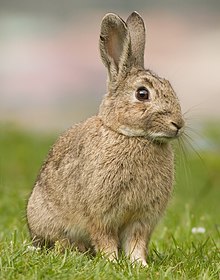
| |
| Scientific classification | |
| Domain: | Eukaryota |
| Kingdom: | Animalia |
| Phylum: | Chordata |
| Class: | Mammalia |
| Order: | Lagomorpha |
| Family: | Leporidae |
| Genus: | Oryctolagus |
| Species: | O. cuniculus[1]
|
| Binomial name | |
| Oryctolagus cuniculus[1] | |
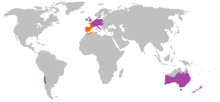
| |
| Range map: Native Introduced
| |
| Synonyms | |
|
Lepus cuniculus Linnaeus, 1758 | |
The European rabbit (Oryctolagus cuniculus) or coney[4] is a species of rabbit native to the Iberian Peninsula (Spain, Portugal and Andorra), western France, and the northern Atlas Mountains in northwest Africa.[5] It has been widely introduced elsewhere, often with devastating effects on local biodiversity. Its decline in its native range due to myxomatosis, rabbit hemorrhagic disease, overhunting and habitat loss has caused the decline of the Iberian lynx (Lynx pardinus) and Spanish imperial eagle (Aquila adalberti). It is known as an invasive species because it has been introduced to countries on all continents with the exception of Antarctica, and has caused many problems within the environment and ecosystems; in particular, European rabbits in Australia have had a devastating impact, due in part to the lack of natural predators there.
The European rabbit is well known for digging networks of
Naming and etymology
Because of its non-British origin, the species does not have native names in
The term "cony" or "coney" antedates "rabbit", and first occurred during the 13th century to refer to the animal's pelt. Later, "cony" referred to the adult animal, while "rabbit" referred to the young. The root of "cony" is the
The species' dwelling place is termed a warren or cony-garth. "Warren" comes from the Old English wareine, itself derived from the Old French warenne, varenne, or garenne. The root word is the
Taxonomy
Originally assigned to the genus
The cladogram is from Matthee et al., 2004, based on nuclear and mitochondrial gene analysis.[12]
| Leporidae |
| |||||||||||||||||||||||||||||||||||||||||||||||||||||||||||||||
Subspecies
As of 2005[update],[13] six subspecies are recognised by MSW3. Genetic studies undertaken in 2008, however, indicate only two subspecies, O. c. algirus and O. c. cuniculus, with a hybrid zone connecting the two populations in central Iberia.[14]
| Subspecies | Trinomial authority | Skull | Description | Range | Synonyms |
|---|---|---|---|---|---|
| Common rabbit O. c. cuniculus ( Nominate subspecies )
|
Linnaeus, 1758 | 
|
Native to most of Europe except eastern, northern, and alpine regions with long-lasting snowfall
Introduced to Australia, New Zealand, Chile, Africa, and several Atlantic and Pacific islands |
fodiens (Gray, 1867) kreyenbergi vermicula vernicularis | |
| Iberian rabbit O. c. algirus |
Loche, 1858 | 
|
Native to Atlantic islands
|
||
| Mediterranean rabbit O. c. huxleyi |
Haeckel, 1874 | Derived from O. c. cuniculus, its size varies from large, hare-like individuals on Desertas, to dwarf forms on Salvages.[15] The rabbits of Madeira are one-third the weight of their mainland counterparts, and have more reddish upper parts and greyer lower surfaces.[16] | Introduced to warm Atlantic islands, including Salvage Islands, and the Azores
|
||
| Cretan rabbit O. c. cnossius |
Bate, 1906 | A small subspecies, similar to O. c. huxleyi.[17] | Native to Crete | ||
| Camargue rabbit O. c. brachyotus |
Trouessart, 1917 | 
|
A black, small-headed subspecies with relatively short ears.[18] | Native to salt marshes of Camargue, southern France | |
| Domestic rabbit O. c. domesticus |
Cabrera, 1923 | Domesticated | |||
| African rabbit O. c. habetensis |
Cabrera, 1923 | Native to | oreas (Cabrera, 1923) |
Fossil record
The oldest known fossils attributed to the modern European rabbit species are around 0.5
Description

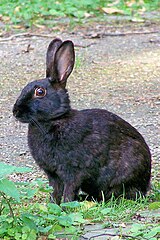
The European rabbit is smaller than the
Size and weight vary according to food and habitat quality, with rabbits living on light soil with nothing but grass to feed on being noticeably smaller than specimens living on highly cultivated farmlands with plenty of roots and clover. Pure European rabbits weighing 5 kg (11 lb) and upwards are uncommon, but are occasionally reported. One large specimen, caught in February 1890 in Lichfield, was weighed at 2.8 kg (6 lb 2 oz).[24] Unlike the brown hare, the male European rabbit is more heavily built than the female.[25] The penis is short, and lacks a baculum and true glans.[9]
The fur of the European rabbit is generally greyish-brown, but this is subject to much variation. The guard hairs are banded brown and black, or grey, while the nape of the neck and scrotum are reddish. The chest patch is brown, while the rest of the underparts are white or grey. A white star shape is often present on kits' foreheads, but rarely occurs in adults. The whiskers are long and black, and the feet are fully furred and buff-coloured.[9] The tail has a white underside, which becomes prominent when escaping danger. This may act as a signal for other rabbits to run.[24]
Life history and behaviour

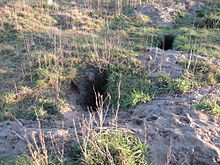
Social and territorial behaviours
The European rabbit lives in warrens that contain 2–10 other individuals living in smaller groups to ensure greater breeding success.[26] Territoriality and aggression contribute greatly to the rabbits' maturation process, and help ensure survival of the population.[27] Females tend to be more territorial than males, although the areas most frequented by females are not defended.[28] Territories are marked with dung hills.[29] The size of the species' home range varies according to habitat, food, shelter, cover from predators, and breeding sites, though it is generally small, encompassing about 0.3–0.7 ha (0.7–1.7 acres). Except during times of low rabbit density and abundance of high-quality food, male ranges tend to be larger than those held by females. The European rabbit rarely strays far from its burrow; when feeding on cultivated fields, it typically only moves 25 m (82 ft) away from its burrow, and rarely 50 m (160 ft). It may, however, move as far as 500 m (1,600 ft) after an abrupt change in environment, such as a harvest. This behaviour may be an antipredator adaptation, as rabbits in areas where predators are under rigorous control may move three times further from their burrows than those in areas without predator management.[30]
The European rabbit is a gregarious animal, which lives in stable social groups centred around females and sharing access to one or more burrow systems. Social structures tend to be looser in areas where burrow construction is relatively easy. Dominance hierarchies exist in parallel for both bucks and does. Among bucks, status is determined through access to does, with dominant bucks siring the majority of the colony's offspring. The dominant does have priority access to the best nesting sites, with competition over such sites often leading to serious injury or death. Subordinate does, particularly in large colonies, typically resort to using single-entrance breeding spots far from the main warren, thus making themselves vulnerable to fox or badger predation.[30]
Reproduction and development
In the European rabbit's
The
Female European rabbits nurse their kits once a night, for only a few minutes. After suckling is complete, the doe seals the entrance to the stop with soil and vegetation. In its native Iberian and southern French range, European rabbit young have a growth rate of 5 g (0.18 oz) per day, though such kittens in non-native ranges may grow 10 g (0.35 oz) per day. Weight at birth is 30–35 g (1.1–1.2 oz) and increases to 150–200 g (5.3–7.1 oz) by 21–25 days, during the weaning period.[33] European rabbit kits are born blind, deaf, and nearly naked. The ears do not gain the power of motion until 10 days of age, and can be erected after 13. The eyes open 11 days after birth.[35] At 18 days, the kittens begin to leave the burrow. Sexual maturity in bucks is attained at 4 months, while does can begin to breed at 3-5 months.[33]
Burrowing behaviour
The European rabbit's burrows occur mostly on slopes and banks, where
Communication
The European rabbit is a relatively quiet animal, though it has at least two vocalisations. The best-known is a high treble scream or squeal.[39] This distress call has been likened to the cry of a piglet.[40] This sound is uttered when in extreme distress, such as being caught by a predator or trap.[39] During the spring, bucks express contentment by emitting grunting sounds when approaching other rabbits. These grunts are similar to shrill hiccups, and are emitted with the mouth closed. Aggression is expressed with a low growl.[40]
Ecology
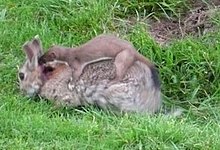
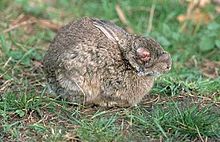
Habitat
The European rabbit's ideal habitat consists of short grasslands with secure refuge (such as burrows, boulders, hedgerows, scrub, and woodland) near feeding areas. It may dwell up to
Diet
The European rabbit eats a wide variety of
Like other leporids, the European rabbit produces soft, mucus-covered faecal pellets, which are ingested directly from the anus.[42] The soft pellets are produced posterior to the colon in the hind gut soon after the excretion of hard pellets and the stomach begins to fill with newly grazed food. The soft pellets are filled with protein-rich bacteria, and pass down to the rectum in glossy clusters. The rabbit swallows them whole, without perforating the enveloping membrane.[45]
Predators
The European rabbit is prey to many different predatory species.
The European rabbit makes up 85% of the
Diseases and parasites
The European rabbit is the only species fatally attacked by myxomatosis. The most lethal strain has a five-day incubation period, after which the eyelids swell, with the inflammation quickly spreading to the base of the ears, the forehead, and nose. At the same time, the anal and genital areas also swell. During the last stages of the disease, the swellings discharge a fluid rich in viral material, with death usually following on the 11th-12th day of infection.[50] In Britain, the primary carrier of myxomatosis is the flea Spilopsyllus cuniculi, while in Australia it is mosquitoes.
Human relationships with rabbits
Recent research has shown that all European rabbits carry common genetic markers and descend from one of two maternal lines. These lines originated between 12,000 and 6.5 million years ago when glaciers isolated two herds, one on the Iberian Peninsula and the other in Southern France. Humans likely began hunting rabbits as a food source, but further research needs to be done to verify this. Little comprehensive evidence of the relationship of humans with European rabbits is documented until the medieval period.[53]
Humans' relationship with the European rabbit was first recorded by the Phoenicians prior to 1000
Like the Phoenicians, neither the later
The European rabbit is the only rabbit species that has been domesticated and all
As an introduced species
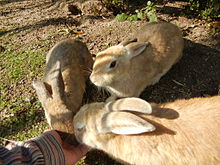
The European rabbit has been introduced as an
Other locations where the European rabbit was introduced include
In the British Isles
The European rabbit is widespread in both Great Britain,
Increases in truly wild populations occurred slowly, primarily in the coastal areas and lowland heaths of
Between 1996 and 2018, rabbit numbers fell by 88% in the east Midlands, 83% in Scotland, and 43% across the whole of the UK. Numbers are still falling (in 2021). Pip Mountjoy, Shifting Sands project manager at Natural England said, "They (rabbits) are actually an endangered species in their native region on the Iberian peninsula. It is surprising for people that rabbits are important in some ecosystems. We think of them as a pest but in Britain they are a keystone species – they act as landscape managers and a lot of other species rely on them." The Shifting Sands project aims to encourage landowners to create safe habitats for rabbits, consisting of piles of branches placed near existing rabbit warrens. Species that depend in rabbits' grazing habits include purple milk vetch, rare spring sedge, spring speedwell, prostrate perennial knawel, caterpillars of the lunar yellow underwing moth, stone curlew, and the large blue butterfly.[65]
In Australia
Twenty-four specimens of the European rabbit were
During the 1950s, the intentional introduction of a virus that causes myxomatosis provided some relief in Australia, but not in New Zealand, where the insect
In Chile
The exact date on which the European rabbit was introduced into Chile is unknown, though the first references to it occur during the mid-18th century. By the 19th century, several authors referred to the presence of both rabbits and rabbit hutches in central Chile. The importation and breeding of rabbits was encouraged by the state, as rabbits were seen as cheap sources of food for peasants. Whether or not their escape into the wild was intentional is unknown, but warnings over the dangers of feral rabbits were raised during the early 20th century, and the species had propagated dramatically by the late 1920s in central Chile, Tierra del Fuego, and the Juan Fernández Islands. In the 1930s, the state sought to tackle the rabbit problem by banning fox hunting, though it was later discovered that indigenous South American foxes rarely preyed on rabbits, preferring native species. In modern times, the European rabbit problem has not been resolved definitively, though a deliberate outbreak of myxomatosis in Tierra del Fuego successfully reduced local rabbit populations. The species remains a problem in central Chile and on Juan Fernández, despite international financing.[66]
Domesticated rabbits
The European rabbit is the only rabbit to be widely
Domesticated rabbits have mostly been bred to be much larger than wild rabbits, though
-
A brown domesticated Netherland dwarf crossbreed "loafing" (legs and paw tucked under the body)
-
A sleeping white spotted Holland lop
-
5 weeks old domesticated bunny of unknown breed
-
A grey Holland lop rabbit
-
A brown domesticated Netherlands dwarf crossbreed
-
An elderly black and white domesticated rabbit of unknown breed
Meat and fur
In the United Kingdom, rabbit was a popular food source for the poorer classes. Among wild rabbits, those native to Spain were reputed to have the highest meat quality, followed by those in the Ardennes. As rabbits hold very little fat, they were hardly ever roasted, being instead boiled, fried, or stewed.[67]
The pelt of the rabbit is heavier and more durable than the hare's.[68] Marshall calculated that the value of the skin in proportion to the carcass was greater than that of the sheep and ox.[69] Its fur is primarily used for felting or hats. It is also dyed or clipped, and sold as imitations of more valuable furbearers, such as fur seal. Although cheap and easily acquired, rabbit fur has little durability.[70]
Conservation status
Though the European rabbit thrives in many of the locations where it was introduced, in its native Iberia, populations are dwindling. In 2005, the Portuguese Institute for Nature Conservation and Forests classified O. cuniculus in Portugal as "near threatened",[71] while in 2006, Spanish authorities (SECEM) reclassified it in Spain as "vulnerable".[72] In 2018, the International Union for Conservation of Nature reclassified O. cuniculus in Spain, Portugal, and France as "endangered", due to the extent of recent declines. Worldwide, the species is also endangered.[3]
See also
- Cuniculture, on the practice of breeding and raising the domesticated version of the European rabbit
- List of breeds of the domesticated version of the European rabbit
References
- OCLC 62265494.
- ^ "Fossilworks: Oryctolagus cuniculus".
- ^ . Retrieved 17 February 2022.
- ^ "coney, n.1". OED Online. Oxford University Press. 1 March 2018. Retrieved 25 April 2018.
- ^ "ADW: Oryctolagus cuniculus: INFORMATION". Animal Diversity Web.
- ^ a b c Barrett-Hamilton, Hinton & Wilson 1910, pp. 177–179
- ^ CNRTL 2012, connil.
- ^ Harting & Shand 1898, pp. 51–52
- ^ a b c d Harris & Yalden 2008, pp. 203
- ^ Barrett-Hamilton, Hinton & Wilson 1910, pp. 173
- ^ Harris & Yalden 2008, pp. 201
- PMID 15503672.
- OCLC 62265494.
- ISBN 978-3-540-72445-2
- ^ Lockley 1976, pp. 146
- ^ Harting & Shand 1898, pp. 15
- ^ Barrett-Hamilton, Hinton & Wilson 1910, pp. 199
- ^ Trouessart, E.-L. (1917). "Le lapin de Porto Santo et le lapin nègre de la Camargue". Bulletin du. Muséum d'Histoire Naturelle. 6: 366–373.
- ISBN 978-3-540-72445-2
- ISSN 0047-2484. Retrieved 25 February 2024 – via Elsevier Science Direct.
- ^ a b Harris & Yalden 2008, pp. 204–205
- ^ a b Harris & Yalden 2008, pp. 202
- ^ a b c Harris & Yalden 2008, pp. 204
- ^ a b Harting & Shand 1898, pp. 13–15
- ^ Barrett-Hamilton, Hinton & Wilson 1910, pp. 199–201
- S2CID 19352143.
- .
- .
- PMID 4676335.
- ^ a b Harris & Yalden 2008, pp. 206–207
- S2CID 53166150.
- ^ Lockley 1976, pp. 97
- ^ a b c d Harris & Yalden 2008, pp. 207–209
- ^ Barrett-Hamilton, Hinton & Wilson 1910, pp. 214
- ^ a b c Barrett-Hamilton, Hinton & Wilson 1910, pp. 210–212
- ^ Lockley 1976, pp. 100
- ^ Barrett-Hamilton, Hinton & Wilson 1910, pp. 202–205
- ^ Lockley 1976, pp. 58
- ^ a b Lockley 1976, pp. 23
- ^ a b Barrett-Hamilton, Hinton & Wilson 1910, pp. 227
- ^ a b Harris & Yalden 2008, pp. 206
- ^ a b c Harris & Yalden 2008, pp. 207
- ^ a b Barrett-Hamilton, Hinton & Wilson 1910, pp. 225
- ^ Harting & Shand 1898, pp. 6
- ^ Lockley 1976, pp. 104–105
- ^ a b c d Lockley 1976, pp. 139–142
- S2CID 52272985.
- ^ Harting & Shand 1898, pp. 39
- ^ Barrett-Hamilton, Hinton & Wilson 1910, pp. 212
- ^ Lockley 1976, pp. 116
- ^ a b c Harris & Yalden 2008, pp. 209–210
- ^ Harting & Shand 1898, pp. 46
- ^ "History of Rabbit Domestication -- Western Europe". Archived from the original on 2011-07-11.
- ^ "The Camel, the Hare and the Hyrax, chapter 6" (PDF). Archived from the original (PDF) on 16 June 2012.
- ^ "ORIGEN IBÉRICO DEL CONEJO". studylib.es.
- ^ Corominas, Joan & José A. Pascual (1980) Diccionario crítico etimológico castellano e hispánico. Vol. 2, s.v. conejo. Madrid: Gredos.
- ^ "Definition of CONEY". www.merriam-webster.com.
- ^ a b López Seoane, V. (1861) Fáuna Mastológica de Galicia, ó historia natural de los mamíferos de este antiguo Reino, aplicada á la medicina, á la agricultura, á la industria, á las artes y al comercio. Manuel Mirás, 544 pages.
- ^ a b Blázquez, J.M. (1975) La romanización. Ediciones Akal, 437 pages.
- ^ Kemppainen, Jouni K. (October 2007). "Kanit keskuudessamme (The rabbits among us)". Suomen Kuvalehti (in Finnish): 76–83.
- ^ Ognev 1962, p. 242
- ^ Harris & Yalden 2008, pp. 205–206
- ^ a b Barrett-Hamilton, Hinton & Wilson 1910, pp. 184–189
- ^ Lockley 1976, pp. 115
- ^ Barkham, Patrick (28 November 2021). "Hope 'rabbit hotels' can help Britain's decimated population bounce back". The Guardian. Retrieved 28 November 2021.
- ^ Camus, Pablo; Castro, Sergio; Jaksic, Fabián. "European rabbits in Chile: the history of a biological invasion". Historia (Santiago) v.4 n.se Santiago 2008. ISSN 0717-7194
- ^ Harting & Shand 1898, pp. 222–248
- ^ Petersen, Marcus (1914), The fur traders, and fur bearing animals, Buffalo : Hammond Press, p. 291
- ^ Barrett-Hamilton, Hinton & Wilson 1910, pp. 188
- ^ Barrett-Hamilton, Hinton & Wilson 1910, pp. 191
- ISBN 978-972-775-153-2. Archived from the originalon 23 August 2021. Retrieved 29 March 2018.
- ^ "SECEM 2006 red list" (PDF). secem.es. Archived from the original (PDF) on 2007-10-06.
Bibliography
- Barrett-Hamilton, Gerald Edwin Hamilton; Hinton, Martin A. C.; Wilson, Edward Adrian (1910). A history of British mammals, v. 2; pt. 2. London : Gurney and Jackson.
- "Centre National de Ressources Textuelles et Lexicales" [National Center of Textual and Lexical Resources]. CNRTL.fr (in French). 2012.
- Harris, Stephen; Yalden, Derek (2008). Mammals of the British Isles. Mammal Society; 4th Revised edition. ISBN 978-0-906282-65-6.
- Harting, James Edmund; Shand, A. I. (1898). The rabbit; with a chapter on Cookery. London, Longmans.
- Lockley, R. M. (1976). The Private Life of the Rabbit. Readers Union Group of Book Clubs.
- Ognev, Sergei Ivanovich (1962). Mammals of Eastern Europe and Northern Asia, Vol. 4. Israel Program for Scientific Translations.
External links
 Media related to Oryctolagus cuniculus at Wikimedia Commons
Media related to Oryctolagus cuniculus at Wikimedia Commons Data related to Oryctolagus cuniculus at Wikispecies
Data related to Oryctolagus cuniculus at Wikispecies
- View the rabbit genome in Ensembl
- View the oryCun2 genome assembly in the UCSC Genome Browser.








